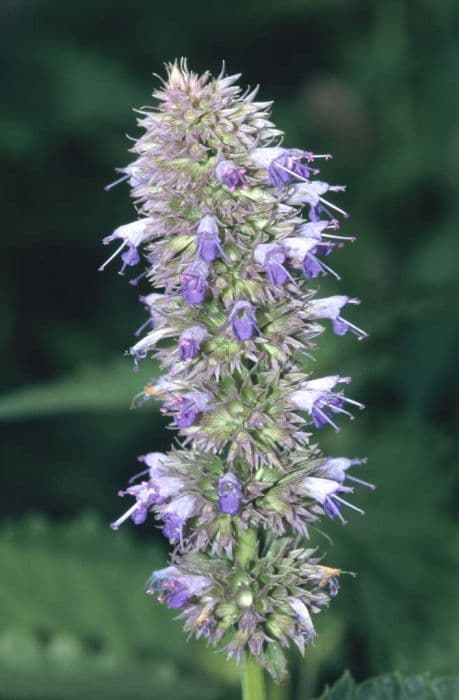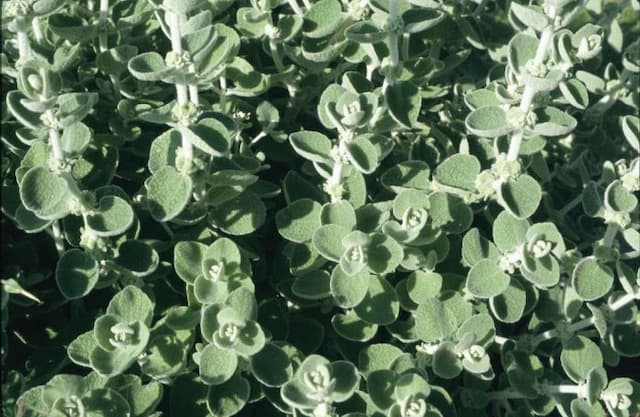Night Butterfly Sage Salvia 'Nachtvlinder'

ABOUT
Salvia 'Nachtvlinder' is a striking perennial plant known for its lush foliage and vibrant flowers. The leaves of this salvia are typically a rich green color, which create a dense backdrop for the blooms. The foliage can be slightly aromatic when brushed or crushed. What sets this plant apart are its stunning flowers that appear on spikes above the foliage. The blossoms are a deep, velvety purple, and they are shaped like small trumpets or tubes, which is typical of many salvia varieties. These flowers are known to attract a variety of pollinators, including bees, butterflies, and hummingbirds, adding to the plant's ornamental appeal. The overall visual effect of Salvia 'Nachtvlinder' is one of a rich tapestry of green punctuated by the dramatic pop of purple floral spikes, which can add a touch of elegance and interest to garden settings where they are featured.
About this plant
 Names
NamesSynonyms
Nachtvlinder Sage, Purple Sage, Ornamental Sage
Common names
Salvia 'Nachtvlinder'.
 Toxicity
ToxicityTo humans
Salvia 'Nachtvlinder', commonly known as Sage, is generally not considered toxic to humans. Eating reasonable amounts of Sage as an herb in cooking is safe, and there's no widely recognized risk of poisoning from casually ingesting parts of this plant. However, consuming large amounts of Sage, especially in the form of essential oils, can potentially cause symptoms such as restlessness, vomiting, vertigo, rapid heart rate, tremors, seizures, and kidney damage. It should be noted that the essential oil contains thujone, which can be toxic in high doses, but the plant as a whole isn't commonly associated with this level of toxicity.
To pets
Salvia 'Nachtvlinder', commonly known as Sage, is not typically considered highly toxic to pets. Dogs and cats that ingest small amounts of the plant may not exhibit any symptoms and will likely tolerate it well as it is not normally a part of their diet. However, as with other non-typical food sources, ingestion of larger quantities may cause mild stomach upset in some pets. If a pet consumes a significant amount of Sage or its essential oils, it could potentially experience more severe symptoms similar to those in humans, including gastrointestinal upset, central nervous system depression, or more seriously heart rate changes. If there is any suspicion of overdose or poisoning, it is important to consult with a veterinarian.
 Characteristics
CharacteristicsLife cycle
Perennials
Foliage type
Deciduous
Color of leaves
Green
Flower color
Purple
Height
1-2 feet (30-60 cm)
Spread
1-2 feet (30-60 cm)
Plant type
Shrub
Hardiness zones
7
Native area
Cultivar
Benefits
 General Benefits
General Benefits- Aesthetic Appeal: The Salvia 'Nachtvlinder', commonly known as Night Moth Sage, features striking deep purple flowers that add a splash of vibrant color to any garden.
- Attracts Pollinators: It is an excellent attractor of beneficial insects like bees and butterflies, which are essential for pollination.
- Drought Tolerance: Night Moth Sage is well-suited for xeriscaping or drought-prone areas, as it can withstand periods of limited water supply once established.
- Long Blooming Season: Its blooming season extends from late spring through to autumn, providing a long period of visual interest.
- Low Maintenance: This plant is known for being low maintenance, requiring minimal care once it is established in the appropriate conditions.
- Herbaceous Perennial: As a perennial, it will return after winter, eliminating the need to replant every year, which saves time and effort.
- Fragrance: The foliage and flowers emit a delightful fragrance that can add another layer of enjoyment to a garden setting.
- Erosion Control: Its root system can help to stabilize soil, making it a good choice for slopes or areas prone to erosion.
- Deer Resistance: Night Moth Sage is generally resistant to deer, which can be particularly beneficial in areas where deer grazing is a problem for gardeners.
- Culinary Uses: While excluding medicinal properties, the leaves of many Salvia species are used for culinary purposes, often to add flavor to dishes.
 Medical Properties
Medical PropertiesThis plant is not used for medical purposes.
 Air-purifying Qualities
Air-purifying QualitiesThis plant is not specifically known for air purifying qualities.
 Other Uses
Other Uses- Artistic Dye: The blossoms of the Night Butterfly Sage, if processed correctly, can be used to create a natural dye for fabrics or paper, providing a sustainable alternative to synthetic dyes.
- Natural Potpourri: Dried flowers and leaves of the Night Butterfly Sage can be added to potpourri mixtures for a pleasant aroma in the home.
- Floral Arrangements: Fresh or dried, the vibrant flowers can be used in decorative floral arrangements to add color and interest.
- Photography: With its striking appearance, the Night Butterfly Sage can serve as an excellent subject for botanical photography.
- Education: The plant can be used in educational settings to teach about pollination, as it is attractive to bees and butterflies.
- Garden Design: Because of its dark foliage and deep purple flowers, it can be incorporated into landscape designs to create contrast with lighter-colored plants.
- Insect Habitat: Night Butterfly Sage can be included in insectary gardens to provide habitat and nectar sources for beneficial insects.
- Crafts: Leaves and flowers of the Night Butterfly Sage can be used to make creative crafts, such as pressed flower bookmarks or plant-based jewelry.
- Culinary Garnish: Although not commonly known for culinary use, the flowers can serve as an edible garnish to add a splash of color to dishes.
- Companion Planting: It may be used in companion planting to help deter pests due to its aromatic properties, which can mask the scent of more susceptible plants.
Interesting Facts
 Feng Shui
Feng ShuiThe plant Sage is not used in Feng Shui practice.
 Zodiac Sign Compitability
Zodiac Sign CompitabilityThe plant Sage is not used in astrology practice.
 Plant Symbolism
Plant Symbolism- Healing - Salvia, commonly known as Sage, is often associated with healing due to its long history of medicinal use.
- Wisdom - Sage has been symbolic of wisdom and knowledge, as its Latin name, "Salvia," is derived from the Latin word "salvere," meaning "to save" or "to heal."
- Protection - In various cultures, Sage is used in smudging ceremonies to purify and protect spaces from negative energies.
- Longevity - Due to its health-associated properties, Sage sometimes symbolizes a long and healthy life.
- Spirituality - It is frequently used in spiritual practices for its ability to connect the physical and spiritual realms and enhance intuition.
 Water
WaterThe perennial salvia, commonly known as 'Nachtvlinder', requires regular watering to maintain moist soil, especially during the growing season. It should be watered deeply once or twice a week, depending on the weather conditions. You might need to adjust the frequency during extremely hot or dry periods to prevent the soil from drying out completely. A good rule of thumb is to provide the salvia with about 1 inch of water, or approximately 0.6 gallons, every week. Ensure the plant has well-draining soil to prevent waterlogging, which could lead to root rot.
 Light
LightSalvia 'Nachtvlinder' thrives best in full sun conditions, meaning it requires at least 6 to 8 hours of direct sunlight each day. The ideal spot for this plant would be in an area where it can receive unfiltered sunlight for the majority of the day. Semi-shaded areas can be tolerated, but blooming may not be as prolific. Avoid deep shade as this can lead to poor growth and sparser blooms.
 Temperature
TemperatureSalvia 'Nachtvlinder' prefers temperate climates and does well in a broad range of temperatures. It can survive minimum temperatures down to around 10 degrees Fahrenheit but may die back to the ground in freezing conditions, emerging again in spring. The plant enjoys ideal temperatures between 60 to 70 degrees Fahrenheit and can tolerate highs up to about 85 degrees Fahrenheit. Providing mulch can help regulate soil temperature and protect the roots in extreme temperatures.
 Pruning
PruningPruning Salvia 'Nachtvlinder' encourages more blooms and maintains a compact shape. Prune the plant in early spring to remove any dead or damaged growth and again after the first bloom period, typically in late spring or early summer, to promote a new flush of flowers. Pruning can be done every few months to tidy the plant, particularly if it becomes leggy or overgrown. The best time for pruning is just above new leaf nodes to stimulate bushier growth.
 Cleaning
CleaningAs needed
 Soil
SoilThe best soil mix for Salvia 'Nachtvlinder', also known as the Pomegranate Sage, should be well-draining and rich in organic matter with a pH range between 6.0 and 7.0. A combination of garden soil, compost, and perlite or coarse sand would provide adequate drainage and fertility. Mulching can help retain moisture and suppress weeds.
 Repotting
RepottingPomegranate Sage should be repotted every 1-2 years to refresh the soil and accommodate root growth. For mature plants, repotting may be less frequent, only when the roots have filled the pot, which could be every 2-3 years.
 Humidity & Misting
Humidity & MistingPomegranate Sage prefers moderate to low humidity conditions, as it is fairly drought tolerant. High humidity can encourage fungal diseases, so it's best to aim for a balance without excess moisture in the air.
 Suitable locations
Suitable locationsIndoor
Ensure bright light, occasional watering when topsoil dries.
Outdoor
Plant in full sun, well-draining soil, water sparingly.
Hardiness zone
8-10 USDA
 Life cycle
Life cycleSalvia 'Nachtvlinder', commonly known as Sage 'Nachtvlinder', begins its life cycle when seeds are sown in well-draining soil and germinate, usually in spring to early summer. The seedlings emerge and develop into young plants, featuring the characteristic foliage and gradually forming a robust root system. As the plant matures, it enters its vegetative phase, where it develops a woody base and branches out, producing lush green leaves. During the blooming stage, typically from late spring to frost, Sage 'Nachtvlinder' produces spikes of deep purple flowers that attract pollinators such as bees and butterflies. After pollination, the flowers may produce seeds, which can be dispersed to give rise to new plants, continuing the cycle. In regions with cold winters, the plant may die back to the ground, becoming dormant until the favorable conditions of spring prompt new growth.
 Propogation
PropogationPropogation time
Spring-Early Summer
Salvia 'Nachtvlinder', commonly known as the Violet Sage, is best propagated through stem cuttings. The ideal time for taking stem cuttings is in late spring or early summer when the plant is actively growing. To propagate, select a healthy, non-flowering shoot and cut a 4 to 6-inch (10 to 15 cm) length, making sure it includes a few leaf nodes. Remove the leaves from the lower half of the cutting and dip the cut end in rooting hormone powder to encourage root development. Then, plant the cutting in a moist potting mix, ensuring at least two nodes are buried in the soil. Place the pot in a warm, bright spot, but out of direct sunlight, and maintain consistent moisture. Roots should develop within a few weeks, at which point it can eventually be transplanted outdoors or into a larger pot.









